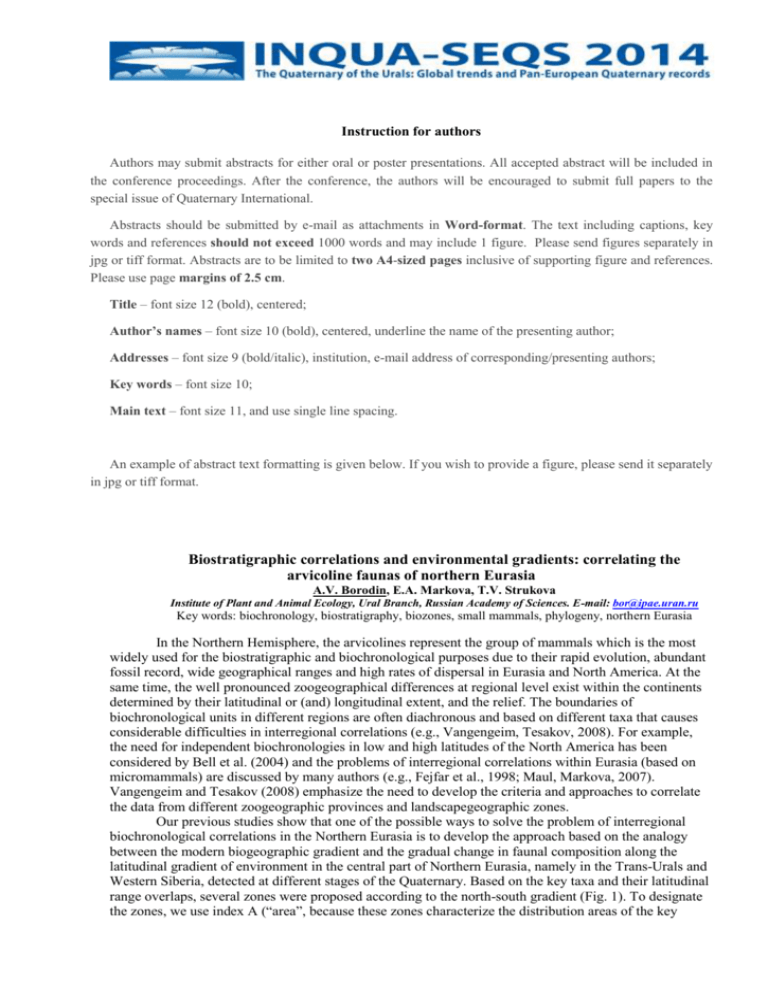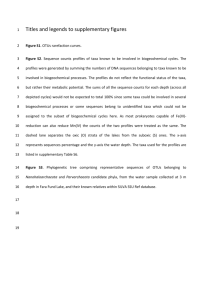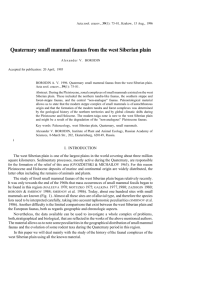Instruction for Authors
advertisement

Instruction for authors Authors may submit abstracts for either oral or poster presentations. All accepted abstract will be included in the conference proceedings. After the conference, the authors will be encouraged to submit full papers to the special issue of Quaternary International. Abstracts should be submitted by e-mail as attachments in Word-format. The text including captions, key words and references should not exceed 1000 words and may include 1 figure. Please send figures separately in jpg or tiff format. Abstracts are to be limited to two A4-sized pages inclusive of supporting figure and references. Please use page margins of 2.5 cm. Title – font size 12 (bold), centered; Author’s names – font size 10 (bold), centered, underline the name of the presenting author; Addresses – font size 9 (bold/italic), institution, e-mail address of corresponding/presenting authors; Key words – font size 10; Main text – font size 11, and use single line spacing. An example of abstract text formatting is given below. If you wish to provide a figure, please send it separately in jpg or tiff format. Biostratigraphic correlations and environmental gradients: correlating the arvicoline faunas of northern Eurasia A.V. Borodin, E.A. Markova, T.V. Strukova Institute of Plant and Animal Ecology, Ural Branch, Russian Academy of Sciences. E-mail: bor@ipae.uran.ru Key words: biochronology, biostratigraphy, biozones, small mammals, phylogeny, northern Eurasia In the Northern Hemisphere, the arvicolines represent the group of mammals which is the most widely used for the biostratigraphic and biochronological purposes due to their rapid evolution, abundant fossil record, wide geographical ranges and high rates of dispersal in Eurasia and North America. At the same time, the well pronounced zoogeographical differences at regional level exist within the continents determined by their latitudinal or (and) longitudinal extent, and the relief. The boundaries of biochronological units in different regions are often diachronous and based on different taxa that causes considerable difficulties in interregional correlations (e.g., Vangengeim, Tesakov, 2008). For example, the need for independent biochronologies in low and high latitudes of the North America has been considered by Bell et al. (2004) and the problems of interregional correlations within Eurasia (based on micromammals) are discussed by many authors (e.g., Fejfar et al., 1998; Maul, Markova, 2007). Vangengeim and Tesakov (2008) emphasize the need to develop the criteria and approaches to correlate the data from different zoogeographic provinces and landscapegeographic zones. Our previous studies show that one of the possible ways to solve the problem of interregional biochronological correlations in the Northern Eurasia is to develop the approach based on the analogy between the modern biogeographic gradient and the gradual change in faunal composition along the latitudinal gradient of environment in the central part of Northern Eurasia, namely in the Trans-Urals and Western Siberia, detected at different stages of the Quaternary. Based on the key taxa and their latitudinal range overlaps, several zones were proposed according to the north-south gradient (Fig. 1). To designate the zones, we use index A (“area”, because these zones characterize the distribution areas of the key taxa). The key lineages and taxa are as follows: †Mimomys intermedius or †M. savini (M.i.) → †A. mosbachensis (A.m.) → †A. chosaricus-kalmankensis (A.ch.) → A. terrestris (A.t.); †Allophaiomys deucalion (A.d.) → †A. pliocaenicus (A.p.) → Microtus (Stenocranius): † Stenocranius hintoni (S.h.), → †S. gregaloides (S.gd.), → S. gregalis (S.g.); †Borsodia newtoni (B.n.) → †Prolagurus ternopolitanus (Pl.t.) → †P. pannonicus (Pl.p.) → †Lagurus transiens (L.t.) → L. lagurus (L.l.); †Praedicrostonyx hopkinsi (Pd.h.) → †Pd. compitalis or †Pd. meridionalis (Pd.m.) → †D. renidens (D.r.) → †D. simplicior (D.s.) → †D. henseli (D.h.) → D. torquatus (D.t.). The latitudinal biochronological zones are established based on the geographic occurrence of the key lineages of Arvicolinae in the Quaternary localities in the Trans-Urals and Western Siberia and entitled using the Latin names of the terminal taxa (at generic or subgeneric level) of those lineages: АI latitudinal zone includes the distribution area of collared lemming (Dicrostonyx lineage); АII zone includes the area of the shared occurrence of Dicrostonyx & Stenocranius; AIII zone includes the area where Dicrostonyx & Stenocranius & Arvicola & Lagurus may be found together; AIV zone includes the area of the shared occurrence of Stenocranius & Arvicola & Lagurus. The zones are numbered sequentially from I to IV according to the north-south gradient in the Trans-Urals and Western Siberia. However, we suggest that the principle of shared geographical occurrence of the key taxa shown in the fig. 1 may be also used in other regions with pronounced latitudinal or altitudinal zonation. Gradual change in species composition over space allows one to link the synchronous faunas of different zones along the environmental gradient based on the evolutionary level of the key taxa. When correlating the arvicoline faunas, any fauna may be placed to a particular spatiotemporal position in the table shown at the fig. 1 according to the evolutionary level of the key taxa and to the range of its distribution in geographical space. For example, a hypothetical fauna comprising Dicrostonyx simplicior, M. (Stenocranius) gregaloides and Lagurus transiens should be placed to the biochronological zone MQR5, and to the geographical zone AIII. A hypothetical fauna comprising the only one species (of the key taxa mentioned above) belonging to Arvicola lineage and corresponding to the evolutionary level of A. mosbachensis should be placed to the biochronological zone MQR3, and to the geographical zones AIII-IV (Fig. 1). The key taxa used here represent the most common arvicolines distributed in the Northern Hemisphere during the Quaternary. By adding the data on the composition of regional faunas for a given period of geological time one may reconstruct the gradients in the composition of micromammal communities along the regional environmental gradients. References Bell C.J., Repenning C.A., Barnosky A.D., 2004. Arvicoline rodents from Porcupine Cave – identification, spatial distribution, taxonomic assemblages, and biochronologic significance. In: Barnosky A.D. (ed.) Biodiversity Response to Climate Change in the Middle Pleistocene – the Porcupine Cave Fauna from Colorado. - California, Berkeley: Univ. of California Press. Р. 207-263. Fejfar O., Heinrich W.D., Lindsay E.H., 1998. Updatind the Neogene Rodent biochronology in Europe. MNITG-TNO. Vol. 60. Р. 533-554. Maul L.C., Markova A.K, 2007. Similarity and regional differences in Quaternary arvicolid evolution in Central and Eastern Europe. Quaternary International. 160, 81–99. Vangengeim E.A., Pevzner M.A., Tesakov A.S., 2001. Zonal subdivisions of the Quaternary in Eastern Europe based on small mammals. Stratigraphy and geological correlation. 9 (3). P. 280-292. Vangengeim E.A., Tesakov A.S., 2008. Principles of construction for the biochronological scales based on the Pliocene and Pleistocene mammals. State of art. Bulletin of Commission for Quaternary Research. N68. P. 59-69 (in Russian). Fig.1. Combinations of the key arvicoline taxa showing the principle of shared geographic occurrence applied to biochronological correlation of the Quaternary faunas of the regions with pronounced environmental gradients in Northern Eurasia. The combinations known in the Trans-Urals and Western Siberia are marked with grey.









